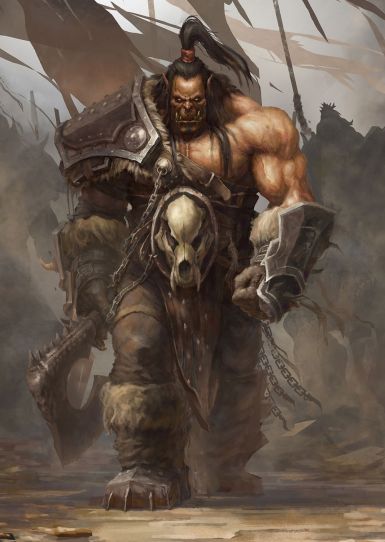Haruchai
| Species | humanoid (orcish) |
| No. Appearing | 15-150 |
| Behaviour | clan |
| Range | alpine, desert, steppe |
| Size | 6 ft., 6-9 in. tall |
| Weight | 295-330 lbs. |
| Intelligence | 11-13 |
| Armour Class | 5 |
| Hit Dice | 2 |
| Action Points | 5 |
| Max. Stride | 9 |
| THAC0 | 20 |
| Hp/Die | 2d4 |
| Attack Forms | claw or weapon |
| Damage | 2–8 or by weapon type |
| Special Attacks | strength 18 |
Haruchai are an aggressive race of robust, close-knit humanoids related to orcs, who in various ways rule over an area in central Asia that is nearly the size of Europe. Locally, they are known by many names: Oirot, Kuan Chu, Jagatai, Tatars, Mongols or Manchu. In some parts, most notably along the northern fringe of the Gobi Desert, they are tribal and resentful of other peoples; but in vast regions they act as a noble class, ruling over cavewights, orcs and ogres. They possess wide and sharp, hatchet-shaped facial features; as shown, they favour growing out their long, straight hair. Their lower teeth grow throughout their lifetimes, so that those with four or more teeth protruding above their upper lips are generally older and more experienced.
History
Haruchai settlements began to emerge about 8,000 years ago with the development of the yurt and domesticated cattle and yak-raising. With the practice of agriculture about 2500-3000, their number increased. A series of wars in the early Bronze Age, circa 2200, with northern hobgoblins and flinds, and with the dwarves of Altslok. Chinese to the south described them as "northern barbarians" beginning with the 8th century BC. During this period they were called the Donghu by outsiders. Between that period and the 300s AD, various confederations and dynasties arose among the haruchai, as they spread westward towards Sinkiang and later through the Dzungarian Gate.
Warring with Turks and other groups, the western haruchai (Oirots) drove these peoples out and occupied their lands. This initiated a wave of barbarians migrating across the Asian steppe, pushing forward Huns, Slavs, Avars and Khazars, later Cumans and Pechenegs, and finally the Turks themselves. In the 10th century, the orcish Khitan peoples were broken and fled west; they settled along the Balkhash between 1100 and 1200, but their presence infuriated the haruchai. Following a 20-year war with Altslok, in which the dwarves held their own, the "Mongol haruchai" were organized under Genghis Khan — who, turning west, destroyed the Khitai along with other lesser peoples. Khwarezmia, Samarkand, Georgia, Kiev, Russia and the Volga Bulgars were smashed and conquered in their turn, establishing haruchai as foreign Padishahs over Persia, Russia and the consolidated Jagatai Empire. By 1279, they had conquered the Song dynasty, bringing China under the control of haruchai overlords until 1368.
The main outward regions of this vast empire have collapsed in the last two hundred years; Moscovy continues to defend its frontier along the Volga against haruchai-orc lands, having failed to hurl these peoples back across the Ural mountains. Persia has been consolidated under the Safavids. Following the conquest of Afghanistan and Central Asia by Tamerlane, a haruchai, these regions have been consolidated under the Mughals, founded by Tamerlane's great-great-great-grandson Babur (who, with his descendents, are a mixed human and orcish bloodline, with the latter much diminished through breeding). Yet in Central Asia, there remain many independent empires and kingdoms that, though lacking unity, continue to hold a tight grip upon a vast area. In each of these, the warring spirit of haruchai continues to foment border wars and unrest in a wide circle of potentially peaceful nations, due to the fear that another Genghis or Tamerlane may arise with each new generation.
Biology
Haruchai females are equally aggressive as males, but after their 15th year, they are possessed with a fierce passion every 18-34 months, most commonly during the dead of winter. This manifests as a delirious frenzy, one that is sometimes murderous; whereupon she will search for a male until successfully copulating. However, if the male found is not strong enough, the attempt will often end in the male's death before the joining is achieved. Upon learning of the female's need, males will often present themselves to the woman to test their personal virility; in many tribes, the male is not granted any authority until they have withstood a haruchai woman's passion. It is not unusual for exceptionally strong women to be overpowered and hobbled before a mating is attempted — though no male admits to this practice.
Gestation is almost certain, resulting in fraternal twins more often than a single offspring. Females will typically carry to term four or five times in their life before the frenzy no longer possesses them. Haruchai become able to fight effectively after age 12 or 13; they rarely live beyond the age of 65.
